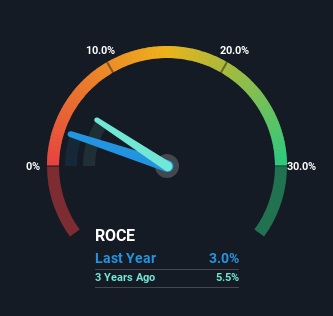- India
- /
- Auto Components
- /
- NSEI:UCAL
Some Investors May Be Worried About UCAL's (NSE:UCAL) Returns On Capital
If you're not sure where to start when looking for the next multi-bagger, there are a few key trends you should keep an eye out for. Firstly, we'll want to see a proven return on capital employed (ROCE) that is increasing, and secondly, an expanding base of capital employed. Ultimately, this demonstrates that it's a business that is reinvesting profits at increasing rates of return. In light of that, when we looked at UCAL (NSE:UCAL) and its ROCE trend, we weren't exactly thrilled.
Return On Capital Employed (ROCE): What Is It?
Just to clarify if you're unsure, ROCE is a metric for evaluating how much pre-tax income (in percentage terms) a company earns on the capital invested in its business. The formula for this calculation on UCAL is:
Return on Capital Employed = Earnings Before Interest and Tax (EBIT) ÷ (Total Assets - Current Liabilities)
0.03 = ₹156m ÷ (₹8.0b - ₹2.9b) (Based on the trailing twelve months to March 2024).
So, UCAL has an ROCE of 3.0%. In absolute terms, that's a low return and it also under-performs the Auto Components industry average of 15%.
Check out our latest analysis for UCAL

Historical performance is a great place to start when researching a stock so above you can see the gauge for UCAL's ROCE against it's prior returns. If you want to delve into the historical earnings , check out these free graphs detailing revenue and cash flow performance of UCAL.
What Does the ROCE Trend For UCAL Tell Us?
On the surface, the trend of ROCE at UCAL doesn't inspire confidence. Over the last five years, returns on capital have decreased to 3.0% from 24% five years ago. Given the business is employing more capital while revenue has slipped, this is a bit concerning. If this were to continue, you might be looking at a company that is trying to reinvest for growth but is actually losing market share since sales haven't increased.
On a side note, UCAL has done well to pay down its current liabilities to 36% of total assets. That could partly explain why the ROCE has dropped. Effectively this means their suppliers or short-term creditors are funding less of the business, which reduces some elements of risk. Since the business is basically funding more of its operations with it's own money, you could argue this has made the business less efficient at generating ROCE.
The Key Takeaway
In summary, we're somewhat concerned by UCAL's diminishing returns on increasing amounts of capital. Despite the concerning underlying trends, the stock has actually gained 3.7% over the last five years, so it might be that the investors are expecting the trends to reverse. Either way, we aren't huge fans of the current trends and so with that we think you might find better investments elsewhere.
One final note, you should learn about the 4 warning signs we've spotted with UCAL (including 3 which shouldn't be ignored) .
For those who like to invest in solid companies, check out this free list of companies with solid balance sheets and high returns on equity.
New: AI Stock Screener & Alerts
Our new AI Stock Screener scans the market every day to uncover opportunities.
• Dividend Powerhouses (3%+ Yield)
• Undervalued Small Caps with Insider Buying
• High growth Tech and AI Companies
Or build your own from over 50 metrics.
Have feedback on this article? Concerned about the content? Get in touch with us directly. Alternatively, email editorial-team (at) simplywallst.com.
This article by Simply Wall St is general in nature. We provide commentary based on historical data and analyst forecasts only using an unbiased methodology and our articles are not intended to be financial advice. It does not constitute a recommendation to buy or sell any stock, and does not take account of your objectives, or your financial situation. We aim to bring you long-term focused analysis driven by fundamental data. Note that our analysis may not factor in the latest price-sensitive company announcements or qualitative material. Simply Wall St has no position in any stocks mentioned.
About NSEI:UCAL
UCAL
Engages in the manufacturers of fuel management systems for the automotive sector in India.
Low risk and slightly overvalued.
Similar Companies
Market Insights
Community Narratives




